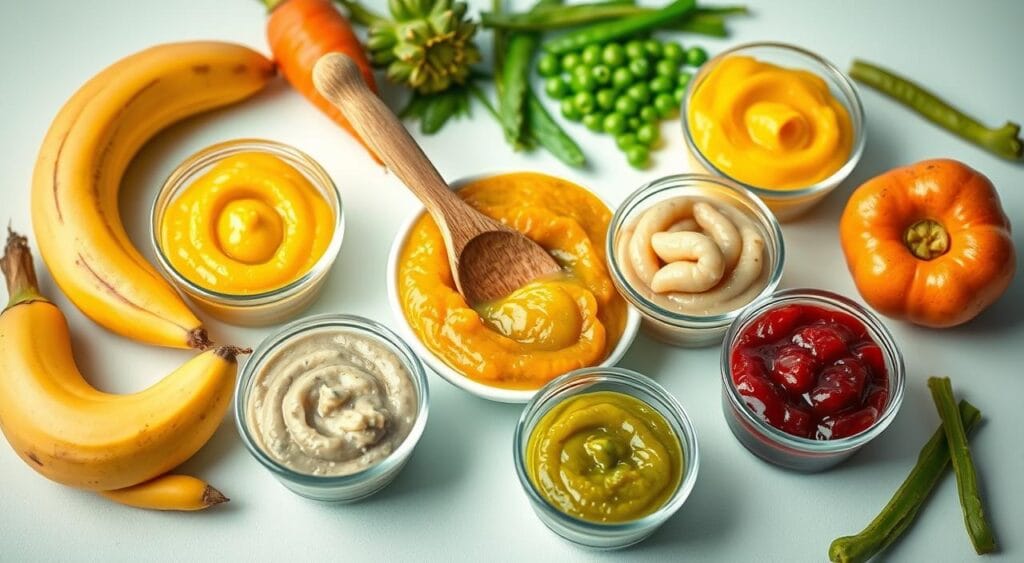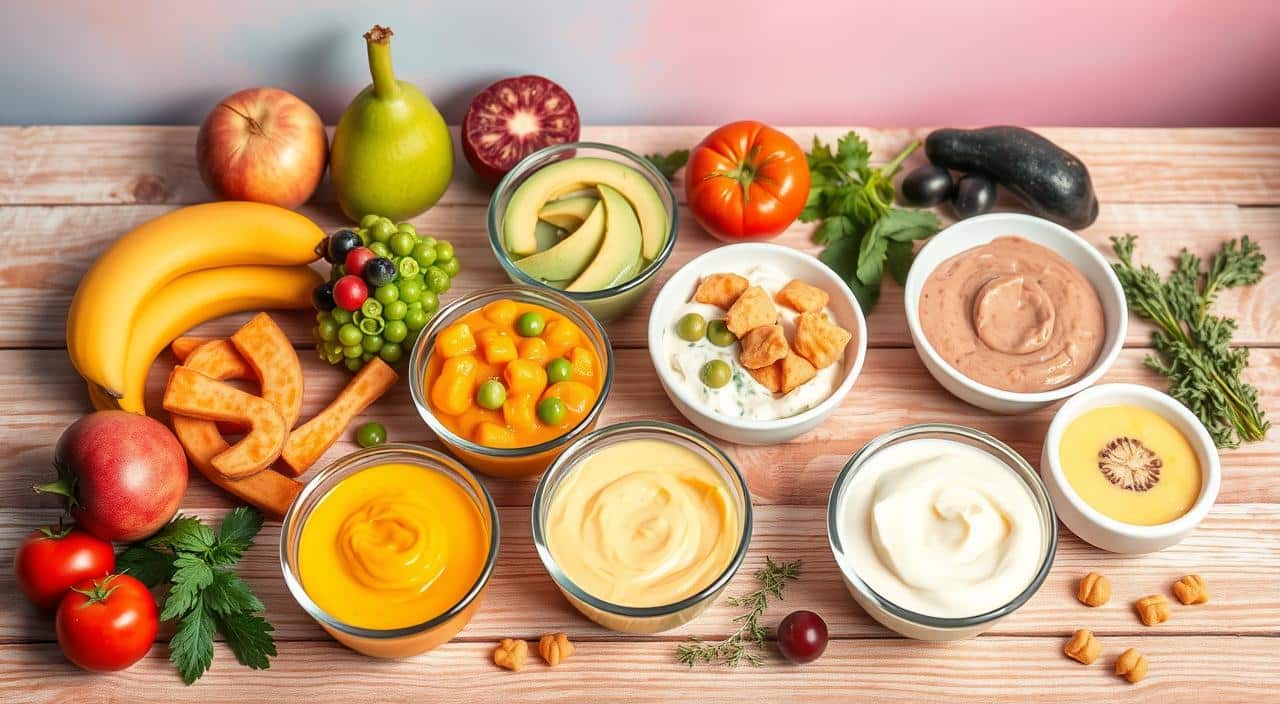Jump to:
Estimated reading time: 11 minutes
Table of contents
What baby foods are good mixed together? Starting your baby’s food journey is exciting. Introducing different baby food combinations is a fun part of it. This guide will help you make tasty, healthy meals for your baby’s growth.
You’ll find many baby food mixes in this article. From simple to complex, these combinations include fruits, veggies, grains, and proteins. They help your baby get a balanced diet and try new tastes.
What baby foods are good mixed together? Key Takeaways
- Discover a wide range of delicious and nutritious baby food combinations to support your little one’s growth and development.
- Learn about the benefits of mixing baby foods, including flavor variety, balanced nutrition, and gradual introduction of new foods.
- Explore beginner-friendly fruit, vegetable, and grain blends as well as more advanced protein-rich and herb-infused combinations.
- Customize baby food mixes based on your baby’s preferences, texture needs, and allergy considerations.
- Avoid common mistakes when mixing baby foods, such as using too many ingredients or overwhelming your baby’s palate with strong flavors.
Introduction
Creating homemade baby food might seem hard, but it’s rewarding and easy. It lets you give your baby many healthy and tasty foods. By mixing and matching different foods, your baby gets to try lots of tastes and nutrients.
This introduction will cover the benefits of homemade baby food and the basic steps. You’ll learn why mixing foods is key and how to make tasty, healthy purees at home. You’ll be ready to start your homemade baby food journey.
Why Mixing Baby Foods is Important
It’s vital to introduce many flavors and textures to your baby early. Here’s why:
- Flavor Variety: Mixing foods helps your baby get used to different tastes and textures. This can stop them from being picky later.
- Balanced Nutrition: Combining foods ensures your baby gets all the nutrients they need.
- Texture Transition: Adding different textures helps your baby learn to chew and swallow.
By making your own baby food, you can adjust flavors and textures to your child’s liking. This makes mealtime fun for both of you.

Getting Started with Homemade Baby Food
Ready to start making your own baby food purees? Here’s what you need to do:
- Choose fresh, high-quality ingredients like fruits, veggies, grains, and proteins.
- Prepare the ingredients by washing, peeling, and cooking them right.
- Blend or puree the ingredients until they’re smooth, adding water or breastmilk/formula if needed.
- Portion and store the food in airtight containers or ice cube trays for easy serving.
- Introduce new foods slowly, waiting 3-5 days between each new item to watch for allergies.
With a bit of planning, you can have a homemade baby food pantry full of healthy, tasty options for your baby.
Why Mixing Baby Foods is Important
Introducing different flavors and textures is key for your baby’s growth. Mixing foods exposes them to more tastes and nutrients. This supports their taste development and ensures a balanced diet.
The Benefits of Combining Foods for Flavor Variety
Mixing baby foods creates unique flavors that excite their senses. This helps them discover new tastes. It also helps prevent picky eating later on.
How Mixed Foods Support Balanced Nutrition
Mixing food groups like fruits, veggies, grains, and proteins makes meals more nutritious. This ensures your baby gets all the vitamins and minerals they need for health and growth.
When to Start Introducing Food Combinations
Start mixing foods around 6 months, when your baby is ready. They should be able to swallow and hold their head up. This is when they can start trying more solid foods.
Remember, breast milk or formula should still be the main food for babies under 12 months. Start slowly and let your baby guide the pace. This makes the transition to solid foods easier and more fun.

“Exposing your baby to a variety of flavors and textures through mixed foods can set them up for a lifetime of healthy eating habits.”
Best Baby Food Combinations for Beginners
Starting with homemade baby food? Begin with simple mixes. These easy baby food combinations and beginner-friendly baby food mixes offer a variety of tastes and nutrients. They help support your baby’s growing taste buds.
What baby foods are good mixed together? Fruit Combinations: Bananas and Avocados
Bananas and avocados are a classic mix. They make a creamy, nutrient-rich simple fruit and vegetable puree. This mix is great for adding baby food with grains like oatmeal or rice cereal.
What baby foods are good mixed together? Vegetable Blends: Sweet Potato and Carrot
Mixing sweet potato and carrot gives you a vibrant, vitamin-packed baby food combination. It’s easy to make and full of important nutrients. These simple fruit and vegetable purees are a great first step for your baby’s solids.
What baby foods are good mixed together? Fruit and Grain Mixes: Apple and Oatmeal
Try blending apples with oatmeal for a beginner-friendly baby food mix. The apples’ natural sweetness goes well with the oatmeal’s heartiness. It’s a tasty and nutritious choice for your baby.
| Combination | Preparation Time | Cooking Time | Servings |
|---|---|---|---|
| Bananas and Avocados | 5 minutes | 0 minutes | 2-3 |
| Sweet Potato and Carrot | 10 minutes | 15 minutes | 4-5 |
| Apple and Oatmeal | 8 minutes | 10 minutes | 3-4 |
“Starting with simple, single-ingredient purees is the way to go when introducing solid foods to your baby. This helps you monitor for any allergic reactions and allows your little one to get accustomed to new flavors and textures.”
Advanced Baby Food Combinations for Older Babies
As your baby grows, they can try more complex foods. These mixtures offer new tastes and textures. They also give important nutrients for your baby’s growth.
Protein-Rich Combos: Chicken and Peas
Adding chicken to your baby’s diet is a great idea. Mix it with peas for extra protein and vitamins. Start with a smooth texture and make it chunkier as they get used to eating solids.
Combining Fruits, Vegetables, and Grains: Spinach, Apple, and Quinoa
Mixing different foods in one dish is good for your baby. Try spinach, apple, and quinoa for a tasty, balanced meal. It helps your baby get used to different flavors and textures.
Adding Herbs and Spices: Cinnamon in Sweet Potato
Introducing herbs and spices like cinnamon can make food more interesting. Cinnamon with sweet potato adds a warm flavor. Start with a little spice and watch for any allergies.
These advanced food combinations help your baby enjoy a variety of tastes. It’s a great start to a lifelong love of healthy, tasty foods.
Healthy Sweet and Savory Baby Food Combinations
Mixing sweet and savory flavors in baby food is fun and healthy. It introduces your baby to different tastes and textures. This helps them enjoy a variety of foods for life.
Mixing Fruit with Yogurt: Blueberries and Greek Yogurt
Fruit and yogurt purees are tasty and full of nutrients. Blend fresh blueberries with Greek yogurt for a yummy mix. Blueberries have antioxidants, and Greek yogurt has probiotics and protein for growth.
Sweet and Savory Combos: Butternut Squash and Pear
Pair the sweetness of butternut squash with the tartness of pear. Butternut squash has vitamins A and C. Pears add fiber and vitamin C. This mix is both tasty and nutritious.
Mixing Vegetables with Mild Proteins: Lentils and Carrots
Combine mild proteins like lentils with vegetables like carrots. Lentils offer plant-based protein, and carrots have beta-carotene. This mix supports your baby’s growth.
Trying these healthy baby food recipes lets your baby enjoy a variety of sweet and savory baby food combinations. These combinations nourish their body and mind.
How to Customize Baby Food Combinations Based on Preferences
As your little one grows, their tastes and needs change. It’s important to customize their baby food to keep meals fun and nutritious. This includes adjusting textures, handling allergies, and introducing new flavors.
Adjusting Textures as Your Baby Grows
At first, your baby likes smooth, velvety purees. As they get older, you can make the food thicker and chunkier. Customizing baby food combinations helps with chewing and swallowing skills.
Making Baby Food Combinations Allergy-Friendly
If your baby has food allergies, it’s crucial to make allergy-friendly baby food. Choose safe ingredients and avoid common allergens. Try different customizable baby food combinations to keep their diet interesting and healthy.
How to Incorporate New Flavors Gradually
Introducing new flavors can be fun for your baby. Start by mixing familiar foods with a bit of something new. Gradually add more of the new ingredient. This way, your baby gets used to customized baby food combinations without feeling overwhelmed.
“The key to creating delightful and nutritious baby food combinations is to listen to your child’s cues and adapt the recipes to their evolving preferences.”
Common Mistakes to Avoid When Mixing Baby Foods
When introducing solid foods to your baby, it’s key to watch out for common mistakes. Preparing and mixing baby foods right can help your child enjoy a wide range of healthy foods. Let’s look at some mistakes to steer clear of when mixing baby foods.
Using Too Many Ingredients at Once
Introducing new foods should be done slowly. Too many flavors and textures can confuse and upset your baby. The Mayo Clinic suggests starting with single-ingredient foods. Then, add new combinations as your baby gets older.
Overloading the Recipe with Strong Flavors
It’s tempting to add bold spices and herbs. But, a baby’s taste buds are still growing. Strong flavors can make meals unpleasant. Use mild, sweet fruits and veggies first, and add stronger tastes slowly.
Not Monitoring for Allergic Reactions
Food allergies are a big worry for many parents. Watch for signs of an allergic reaction, like hives or vomiting. Studies show introducing allergens early can reduce allergy risks. But, always watch your baby’s reaction closely.
Avoiding these mistakes helps ensure your baby’s safety and comfort. This way, you can explore mixed baby foods with confidence. Your child will enjoy a varied, healthy, and tasty food journey.
Frequently Asked Questions: What baby foods are good mixed together?
Can I mix fruits with vegetables for baby food?
Yes! Mixing fruits and vegetables is a great way to add sweetness to vegetables that might otherwise taste strong for babies. Try apple with green beans, pear with peas, or mango with carrots for a balanced taste and nutrient profile.
Are grains good to combine with baby foods?
Absolutely. Adding grains like oatmeal or quinoa to fruits and vegetables creates a more filling meal. Oatmeal with banana, quinoa with sweet potato, or rice with peas are all excellent combinations that provide carbohydrates, protein, and essential minerals.
What proteins can I mix with baby food?
Soft proteins like pureed chicken, lentils, and Greek yogurt pair well with vegetables and grains. For example, chicken with sweet potato, lentils with carrots, or yogurt with blueberries all provide balanced meals rich in protein and vitamins.
Conclusion: Helping Your Baby Enjoy a Variety of Nutritious and Tasty Foods
Learning about different foods can greatly help your baby grow and develop. By introducing many tastes and textures, you help your baby love food. This love will last a lifetime.
Start introducing solid foods when your baby is about 6 months old. At this time, breast milk or formula should still be their main food. Start with small amounts of single foods. Then, slowly add new tastes and textures.
It might take your baby up to 10 tries to like a new food. Make sure to avoid foods that are too sweet or salty. Also, make sure they get all the vitamins and minerals they need.
By making tasty and healthy food mixes, you support your baby’s growth. You also help them appreciate nutritious and tasty homemade baby food. Try out different flavors and textures. Enjoy watching your baby discover the joy of trying new foods.






